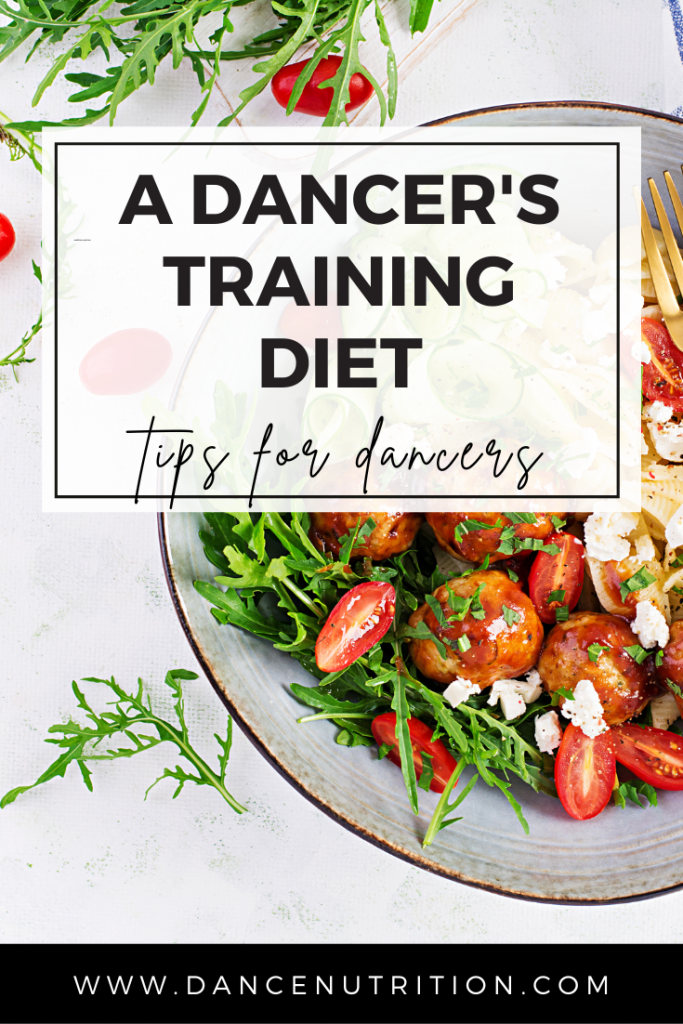When it comes to a dancer’s schedule, training takes up the bulk of time. While some dancers might be in the studio 4–5 hours per week, others can log up to 30 hours of dancing weekly. But training goes beyond time spent at the barre. It often includes strength-building, conditioning, and cross-training workouts designed to improve endurance and prevent injury. (I talk more about cross-training here.)
Whether you’re dancing a few hours or committing to a full-time training schedule, your body needs consistent nourishment to support this demand. That’s where your training diet comes in.
Training Nutrition vs. Performance Nutrition: What’s the Difference?
While performance nutrition focuses on fine-tuned strategies timed around rehearsals, tech weeks, or show days, your training nutrition is about building long-term patterns. Think of training nutrition as the foundation: it supports your energy, recovery, focus, and resilience over time—whether or not you have a performance coming up.
Let’s quickly break it down:
Performance Nutrition For Dancers
This approach is strategic and short-term. It focuses on:
- Pre-performance fueling (1–4 hours before dancing)
- Recovery nutrition (within 60 minutes post-performance)
- Practical food choices for backstage or on-the-go (like shelf-stable snacks and easy-to-digest options that won’t stain your costume!)
During performance weeks, dancers might prioritize quick, convenient foods— even processed snacks, shakes, fruit pouches, or sports drinks— to reduce stress and support energy without triggering digestive issues. For some dancers, overcoming food rules and fears about processed foods is a must.
Essentials For A Dancer’s Training Diet
This is about creating sustainable, nourishing habits that meet your body’s evolving needs over time, especially during off-seasons or less intensive weeks. There’s less periodization and more focus on overall patterns that add up to major outcomes.
To get started, here’s how dancers can maximize their training despite not having performances in their foreseeable future.
#1: Prioritize Consistency with Meals and Snacks
Aim for a general structure of three meals and two snacks daily. This framework helps regulate energy levels and prevents extremes in hunger or fullness. If you find yourself getting too hungry and then too full, it may be a sign that your intake needs more consistency.
#2: Fuel Before and After Class
Even during non-performance periods, your body still needs balanced meals and snacks to support recovery and muscle growth. Don’t fear calories, and include all three macronutrients— carbs, protein, and fat— in your fueling plan.
- Complex carbs (like oats, whole grains, beans) support digestion and long-term energy.
- Unsaturated fats (like nuts, seeds, and avocado) help reduce inflammation and promote recovery.
#3: Don’t Skip Meals
Skipping meals can lead to fatigue, poor focus, and subpar training sessions. Use your training season to build habits that will sustain your performance load later on. Regular nourishment now = stronger performances later.
#4: Stay Hydrated
Proper hydration supports everything from circulation and digestion to skin and mood. Don’t underestimate the power of water throughout your training day. (Not sure how much you need? Click here.)
#5: Be Mindful of Alcohol, Especially During Training
In the short term, excessive alcohol consumption is both hazardous and impairs judgment. In the long term, excessive consumption can leave you dehydrated. Being hydrated when dancing helps to maintain normal blood flow, which is essential for the movement of oxygen and nutrients to and from our working muscles.
#6: Support Your Hormonal Health
If you’re missing a period for three or more consecutive months, then you’ll need to consider tailoring your meal plan to support the return of regular menstruation (learn more here). Menstruation and bone health go hand-in-hand. Hormonal health is also important for male dancers. Eating enough fat throughout the day is key to hormonal balance. Ensure you’re eating enough fat, including sources like:
- Full-fat yogurt
- Avocados
- Flaxseeds and walnuts
- Tuna and salmon
- Vegetable oils and butter
Under-fueling while training will create a landscape vulnerable to bone injury. If time constraints are impacting your ability to eat enough, work with a licensed professional to adjust your schedule and fueling plan accordingly.
#7: Prioritize Rest and Sleep
Recovery happens during rest, especially while you sleep. Sleep supports muscle repair, mental clarity, and emotional regulation. Learn how much sleep dancers need (and what foods might support better sleep) in this post.
#8: Build a Healthy Relationship With Food
This might be the most important piece of your training plan. Dancers are at an increased risk for disordered eating, which can quietly disrupt progress, even if you’re eating “healthy.” Your mindset around food affects your energy, focus, and joy in the studio.
Work to unlearn food rules, normalize all foods, and adopt a flexible approach to fueling. If you’re not sure where to start, this article offers step-by-step guidance.
Key takeaways
A dancer’s nutrition needs aren’t static. They shift depending on your training schedule, seasonal demands, injury status, and recovery needs. Whether you’re off-season, in rehearsal mode, or bouncing back from a setback, your training diet lays the groundwork for performance readiness.
Prioritizing meal consistency, hydration, hormone health, and your relationship with food will create a solid nutritional foundation. If you’re looking to personalize your plan, working with a licensed dance dietitian can help tailor your fueling strategy to match your unique goals and schedule.




